#Agricultural Museum of Egypt
Video
A peacock at Egypt's Spring Flowers Fair 2023 by Zeinab Mohamed
Via Flickr:
A peacock or Indian peafowl at the Agricultural Museum of Egypt in Giza during the Spring Flowers Fair 2023. لطاووس هندي في متحف الزراعى في الجيزة خلال معرض زهور الربيع 2023 فى مصر.
#Egypt#Giza#Egyptian Museums#Agriculture#Agricultural Museum of Egypt#Agricultural Museum#Museums#Africa#North Africa#Mideast#Middle East#MENA#Sony a6500#Sony Alpha#Peacock#Birds#Indian peafowl#Spring Flowers 2023 Fair#Spring#flickr
2 notes
·
View notes
Text

Statuette of a Hippopotamus
In ancient Egypt, faience Hippopotamus statuettes held significant symbolism. These statuettes, commonly known as “hippopotamus figurines,” were crafted from faience, a type of ceramic material.
The symbolism associated with these figurines is primarily linked to the protective and apotropaic (warding off evil) qualities attributed to the hippopotamus in Egyptian culture.
The hippopotamus was considered a dangerous and unpredictable creature due to its aggressive nature and its association with the Nile River, which was vital for agriculture and daily life in ancient Egypt.
Middle Kingdom, 11th to 12th Dynasty, around ca. 2000 BC. Now in the Kunsthistorisches Museum, Vienna. INV 4211
Read more
200 notes
·
View notes
Text

Part 1:
Summary: Y/n arrives at a museum and meets Steven Grant. this one discovers that Y/n is not the one he thinks
Steven grant x reader
Y/n had just entered the british museum when she met a man.
He must have been tall, but how he stood he looked smaller. he had curly black hair. and olive skin
Y/n says "hi" when she discovers that the man was looking at her
"Hello" The boy says in a small voice as he looks at you
"Are you looking for something spec-"
He stops, his breath caught in his throat at you're beauty. He blushes a little
"Sorry im just... you are very beautiful..." He says as he tries to keep his cool
« Ooh thank you you are beautiful too » Y/n respond
"Y-You think so?" The boy smiles as he blushes a little more
"Well... what's you're name? Im Steven." He holds out his hand to shake yours
« Yes really. I m Y/n »
"Well Y/n, are you looking for something specific here? Maybe i can help you..." The boy smiles as he looks at you with soft green eyes
"or... would you like to just... hang out with me? I can show you some of the more... cool artifacts."
« I would really like to take a tour with you. are you a tour guide »
The boy smiles gently, feeling very flattered at you're question. He nods excitedly "Well yes, i am a tour guide. I love showing people the good things at the museum! Come with me!"
He says with an excited smile, pointing at the museum behind him. He seems very knowledgeable about the artifacts and history surrounding them and is able to answer most questions you can think of with ease
« wow you are really very passionate about all this it's crazy »
The boy blushes a little "Thank you... it's just... i love the history of this stuff, like i could spend all day talking about Egypt and it's gods and history with you. Do you like... Egypt too?"
The boy looks at you very excitedly, wondering if you shared the same passion he did, because he really wanted to share what he knew with you "How about you... what do you like? Besides being beautiful..."
"Oh thank you" Y/n blushes at this compliment
« I prefer Greek mythology but I like to learn different things and ancient Egypt is one of them »
"You like greek mythology? That's really cool! Is there anything in there that you like? I really like some of the greek gods and goddesses but my main thing is Egyptian." The boy smiles as he talks about the different mythologies. He gets really talkative when it is a subject of something he enjoyed
"There are a lot of things that are... similar actually, especially in a god like Hades, he is kind of similar in roles to Anubis, who is very similar to Osiris. I love learning about new mythologies but especially ancient Egypt"
« you must be really smart »
The boy blushes "I guess... i just know quite a bit about it..."
He chuckles at you "Why don't you ask me something then! I bet i could answer it!" The boy beams up at you, feeling like he can impress you by answering your every question about ancient Egypt
« Ok so which egyption god is the worst? »
His eyes light up with excitement "That would be Set! He is the god of chaos. He's really cruel to everyone and is one of the only... evil gods. He's also the god of storms, which makes him also similar to Zeus, but Set is always cruel and evil and i'm personally not a big fan of him." He says with a shudder
« and suddenly which god is your favorite? me it's taouret »
"My favorite... well that would have to be Thoth or Osiris. In my knowledge Thoth is the god of wisdom, writing and he is a patron of science and the moon. He is an all knowing god, he can write anyone's future in a book and read it. Osiris on the other hand is the god of the dead, the afterlife, but he also has other domains like fertility and agriculture and he is the first king to be considered a god."
« ok and what do you think of the god khonshu? »
"Oh! He is really bad... He is the god of the moon, but he is also the god of justice. He is also associated with healing and the night time. I'm actually a little surprised you know about him, i thought he wasn't one of the more popular gods... " The boy smiles a little as he talks about the god of the moon "What made you ask about Khonshu?"
« steven you are a nice guy but i am here for another reason. i know you are the avatar of khonshu or rather marc »
The boy looks away for a second, a bit shocked before he turns back to you.
"Y-You know i'm the avatar of Khonshu.... how did you find out?" He says in a small voice, almost whispering
« because I'm not from here and I really know everything, it's complicated to explain »
"You're not from... Here? Are you from a place where the Egyptian gods were actually real or something? Is that possible?"
The kid says, eyes wide with wonder as he tries to figure out where you came from. His whole world view was just turned upside down, was this girl an ancient Egyptian god in disguise or was she from some strange alternate universe where the Egyptian pantheon was still real. Either way, his curiosity got the better of him as he looked at you, almost in a bit of a wonder. The idea fascinated him.
« you're a really smart boy, i'd rather you see me as an egyptian goddess than reality »
The boy smiles up at the girl and looks at her in awe. "So you're a goddess? What goddess are you?"
He asks in wonder "Or are you too powerful to belong to an ancient pantheon like the gods of Egypt, and so you're from... i don't even know, a new and older pantheon? It's amazing to think of... a real goddess."
He says with a soft smile. "Tell me about it then... what exactly are you. What can you do? Just how powerful are you?"
« as I told you, I really like the goddess taouret perhaps because I am her. on earth my powers are not as powerful but I can teleport myself or things, open portals »
The boy's jaw drops at your comment.
"You're Taouret? The goddess of child birth, protection, happiness and cats? That's... So cool! Does that mean that there are more gods like you walking among us? What made you come to earth?"
« it was really boring up there, fun stuff always happens in earth. when i felt khonshu's presence, i was surprised to find you. but in the end it was a good surprise »
The boy smiles at you.
"So... what do you do for fun on earth? I mean... are there any fun activities that a goddess can do? Or is that below you... i don't know. Do you watch movies and read books or are you just here to... i dunno? Do you have any other friends on earth or anything?" The questions just seem to come pouring out of the boy, he's never actually spoken to a god before so he has no idea what is or is not appropriate to ask or say.
« infact on earth I spend most of my time reading, full of books, all different.For friends no. you know steven the gods are very arrogant, it's hard to really be you with them.And for human friends, well I might . you humans are cool. but it's complicated, always having to lie about who I really am. »
The boy sighs a little.
"That's true. I never really thought if gods could have friends since... you are sort of on your own level. And it would be hard to... you know have friends when you're so much more than everyone around you... it... is... lonely... " The boy says as his eyes widen with the reality and realization of what you said. He seemed to understand the way that you would feel. Being alone in a world where you were so much more powerful than everyone around must be... hard. No one else could understand.
« and you, I am convinced that you have lots of friends with all the knowledge you have? maybe even a girlfriend? »
The boy stops for a second and thinks "I... actually don't have that many friends or a girlfriend. You know... i spend a lot of time reading and learning stuff so everyone always thinks i'm weird. They dont get the stuff i'm interested in and they think it's boring and it makes the stuff i'm really into... harder to talk about. So i end up just... keeping to myself i guess. It's not the worst thing but... i mean. It does get pretty lonely you know?"
« you know what if you want we could be friends! »
The boy's eyes light up
"Is that an official goddess offer to be my friend? Because i would really love that. You are a really cool person and i would love to be friends with you"
« so there you go Steven you are my very first friend »
The boy smiles widely.
"And you are my first goddess friend... so i guess that makes the two of us special doesn't it?" He says with a chuckle as he takes your hand and shakes it with a grin. He seems really happy
Y/n smile « yes »
He chuckles happily
"So what's it like having an actual goddess for a friend? Does that mean you can give me favors or make me win in games? I won't tell anyone i swear"
he says with a laugh, a little too playfully, teasing a little
« why not. I could knock the quills down when you bowlin » she laughs
He chuckles and smiles
"That would really be something for the record books! "I won at bowling using divine powers" that should definitely be on the news!"
He chuckles as the idea of that was quite hilarious to him but he would definitely not mind winning a few games with some divine assistance... for as long as it stayed just between you two.
« well I'll let you work it would be a shame if donna came to scold you. but if you want we could meet again? »
He nods
"Yeah that would be cool. Do you have a way i could like... contact you or find you again or something?" He says with a soft smile "Because that was really great you know!" He smiles at you
« yes of course » Y/n give her phone numbers.
"send me a message" Y/n give him a wink
The boy blushes a little before taking your number
"T-Thank you..." he says with a smile as he puts your number in his phone
I'll be sure to message you." He says with a chuckle as he blushes a little
He smiles at you once more "Thank you... i'll talk to you later" He says as he waves, his cheeks red.
to be continued…
#steven grant x reader#moon knight x reader#marc spector x reader#jack lockley x reader#Steven grand#marc Spector#Jack lockley
49 notes
·
View notes
Text
You can a different experience enjoying to learn more about the Egyptian civilization during luxurious trip on Nile cruise
#Travel#tourism#Cairo#Egypt#Pyramids#come_to_Egypt#Tour#Vacation#trip#day tour#cruise#Nile#Luxor#Aswan#Cairo_top_tours
2 notes
·
View notes
Text
Fayoum hosts 'Safe Sanctuary for Wildlife,' encourages tourism

Fayoum governorate will host one of the most promising projects in an effort to develop a new kind of tourism, dubbed "Safe Sanctuary for Wildlife."
The project, which will be established in collaboration with the Kingdom of Jordan as represented by Princess Alia Bint Al-Hussein, is situated on 1,000 acres in the Wadi Al-Rayyan Reserve in the Fayoum Governorate.
Fayoum is a large oasis in Egypt, located about 100 kilometers southwest of Cairo. It is a popular destination for Cairo day tours, and there are a number of different tours available.
The project aims to establish a safe haven for abused and rescued animals, as well as programmes to attract local and foreign tourists, as well as the creation of an educational programme for both adults and children. It also aims to establish a recycling project in the Wadi El Rayan Reserve, with the possibility of connecting the project with educational programmes for local schools, to improve the environment and create new job opportunities.
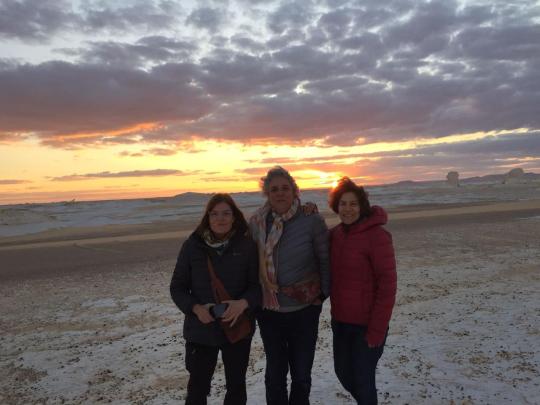
In addition to these two main attractions, Fayoum also has a number of other historical and cultural sites, including the ruins of the ancient city of Crocodilopolis, the Temple of Qasr Qarun, and the Fayoum Museum you can visit during your Egypt trips.
also, the Fayoum Desert Safari tour takes you on an adventure through the Fayoum Desert. You'll camp under the stars, go sandboarding, and visit a traditional Bedouin village with our Egypt desert safari tours.
The safe haven also entails the establishment of a school for students with mental and physical disabilities in collaboration with academic institutions and non-governmental organizations. The project to plant native trees in the reserve is being carried out in conjunction with the Ministry of Agriculture and Botanical Gardens.
The project also entails setting up 50 eco-friendly hotels for passing tourists and providing the necessary training for teachers at that institution. as a reserve.

with our Egypt Classic Tours take you to the most famous sights in Egypt, including the Giza Pyramids, the Sphinx, the Egyptian Museum, and the Valley of the Kings
The governor of Fayoum emphasised the media's role in spreading awareness of the value of protecting reserves as a global resource. He said that the various media outlets will be informed of the safe haven project's implementation steps, one at a time, and expressed his hope that the project would succeed in its intended objectives.
The National Initiative for Smart Green Projects, which was held under the auspices of President Abdel Fattah El-Sisi, President of the Republic, he continued, was an ambassador for the governorate, and the Safe Haven for Wildlife project was honoured during the activities of the national conference to announce the results of the winning projects.
No matter what your interests are, there are sure to be Egypt tour packages that are perfect for you. So start planning your trip today and experience the wonders of this ancient land for yourself.
6 notes
·
View notes
Text
Last day of my vacation, currently on the train home.
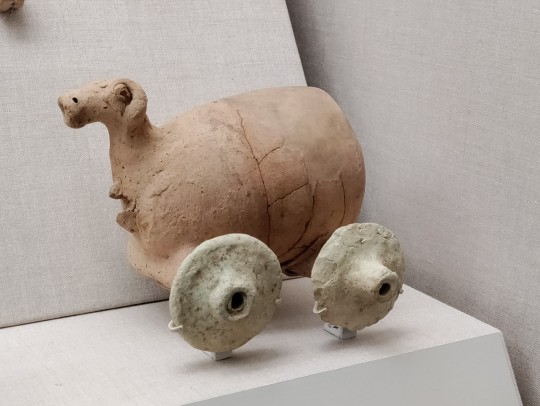
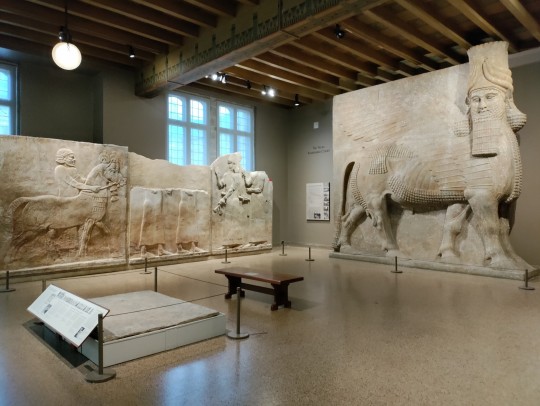
I went to the restaurant next to my hotel for pancakes and bacon, tasty.
I deliberately didn't plan anything huge today, so I wouldn't miss my train around 6.
Instead I went to the Oriental Institute at the University of Chicago!
I know the name sounds concerning, but the founder was actually much better than most white archeologists in the 1920s. His idea was "what if Rome and Greece weren't actually the place all western civilization originally came from, who then spread their knowledge to the savage peoples? What if instead the 'Orient'/Middle East first came up with agriculture?"
And he invented the term "fertile crescent" to support his theory. So overall, way outperforming his time, and I see why the university keeps the institute title for the reputation.
It's a very cool museum of ancient history of the middle east.
The first room is fairly nice, lots of clay bowl and beads, and a display on the invention of writing. Recording numbers of objects (like how many bushels of grain you owe someone) actually came before writing down speech!
The sheep with wheels is listed as a pull toy, and if you look at the front you can see where the rope attaches.
(Sidenote, apparently back in the day archaeologists just got a fraction of items found to take home with them? Like, the University of Chicago archaeologists did an expedition to uncover a site in Egypt that likely had an ancient civilization, so the government in Egypt has most of the items for their museums but the University got to keep 10% or whatever.)
But what's really cool is the giant statues and reliefs.
The picture undersells it, honestly, the wall carvings are around 8 feet tall, and the winged bull man is HUGE
They also have a whole bunch of other wall reliefs from this same ancient temple/administrative office in the next room. There's a lot of cool explanations that I have unfortunately already forgotten.
Anyway, that's where I spent most of the afternoon!
I wanted to see the Tiffany done at the Chicago cultural center, but apparently they stop letting people in more than 15 minutes before closing so they can clear the building.
I went to union station blissfully unaware of all the computer issues they've been having. Through pure luck, my train is the first one to Michigan in about a day and a half NOT to be canceled or delayed!
The train is very full though. Found another quiet 20 something lady to share a row with and ignore each other with headphones in though, so I'm good.
Back to regularly scheduled (aka very infrequent) posts tomorrow.
2 notes
·
View notes
Text
These Mighty Pyramids Were Built By One of Africa’s Earliest Civilisations! The Mysterious Rulers of Nubia, in Present-day Sudan, Erected Hundreds of Tombs and Temples that Rival Cairo’s.
— By Emma Thompson | 29 December 2022 | Photographs By: Nichole Sobecki
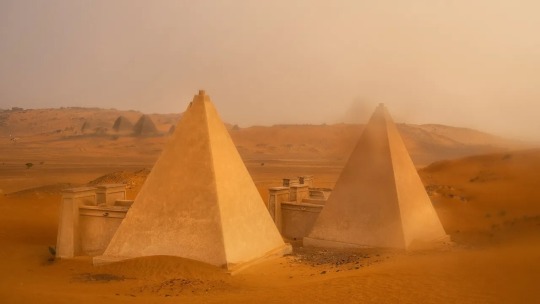
A “haboob” (sandstorm) rolls across the Meroë pyramids in Sudan. Most of the 41 tombs here belong to the royals of the powerful Kingdom of Kush (900 B.C. to A.D. 400), which ruled large parts of the middle Nile Valley.
Powered by agriculture, ancient Sudan’s great civilisations thrived and erected mighty temples and tombs honouring their gods, kings, queens, and nobles. Their building boom left behind some 255 pyramids—more than twice the number Egypt constructed next door.
Yet few Western travellers have seen these hulking sandstone relics. That’s because Sudan’s tourism industry has been impeded by two civil wars (1956-1972 and 1983-2005) and the battle for independence that led to the creation of South Sudan in 2011.
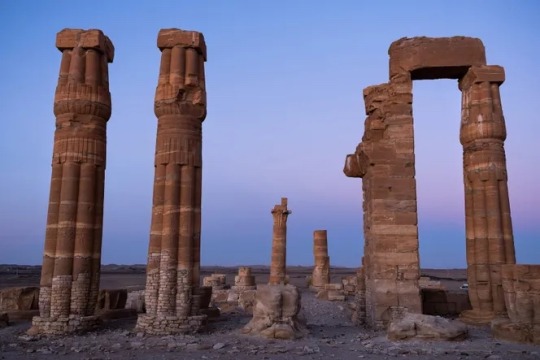
The temple of Soleb was built in the 14th century B.C. by Pharaoh Amenhotep III, in present-day Sudan. Visitors can still view its massive columns and splendid relief carvings.
Travel to Sudan is still currently not advised due to ongoing civil unrest related to a 2021 coup. However, when tensions ease, Sudan offers a singular chance to camp beside crowd-free ancient pyramids and to learn about the mysterious reign of these little-known pharaohs. A guided road trip along the Nile Valley takes you from the splendid temple at Soleb to the UNESCO-recognized Meroë, with the world’s largest cache of pyramids.
Black Pharaohs and a Once Great City
Nubia once stretched south from Aswan, Egypt, to modern-day Khartoum, Sudan. It gave rise to one of Africa’s earliest civilisations, the Kingdom of Kush, whose kings—nicknamed the Black Pharaohs—conquered Egypt in 747 B.C. and ruled the vast territory for nearly a century.
This drama played out on the banks of the world’s longest river, the Nile. Flowing south to north from Lake Victoria to the Mediterranean, the legendary waterway was considered the source of life itself because the annual flooding brought fertile soil for farming.
From the capital of Khartoum, it’s a nine-hour drive north to Soleb, Sudan’s best-preserved temple and the southernmost structure built by Amenhotep III, the Egyptian pharaoh who also commissioned the temples at Luxor. It was once guarded by the Prudhoe Lions, a pair of finely carved red granite beasts inscribed by the boy-king Tutankhamun when he visited. They are now displayed at London’s British Museum.
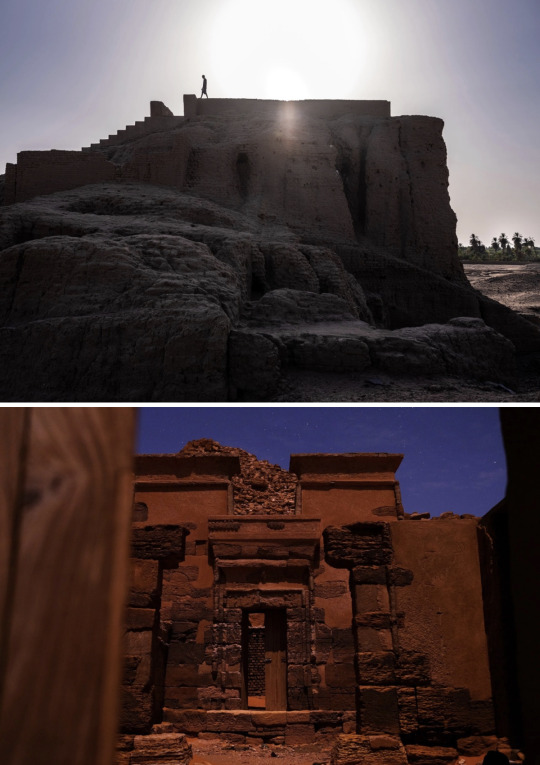
Top: Visitor Nadeem Abduraziq Mohammed walks through the ancient city of Kerma, Sudan, in July 2021. Kerma has been occupied for at least 8,000 to 10,000 years, reaching its peak around 1800 B.C., when it was capital of the Kingdom of Kush. Bottom: There are 41 tombs in Meroë’s north cemetery, 38 of them belonging to monarchs who ruled the region between B.C. 250 and A.D. 320.
Take a small barge from the village of Wawa to the western bank of the Nile, and you soon see the sandstone columns of Soleb’s main hall. Carved at their bases are images of Assyrians, hands chained behind their backs, whom the Black Pharaohs took as prisoners of war.
A few miles south of Soleb, set back from the tents where locals serve small glasses of tea beside the Nile, is Kerma. Established around 5,500 years ago, this ancient capital grew up around a huge adobe temple called the Western Defuffa. At its height the city had a population of 10,000; today, its mud brick ruins are inhabited only by nesting swallows. Nearby lies one of the oldest cemeteries in Africa.
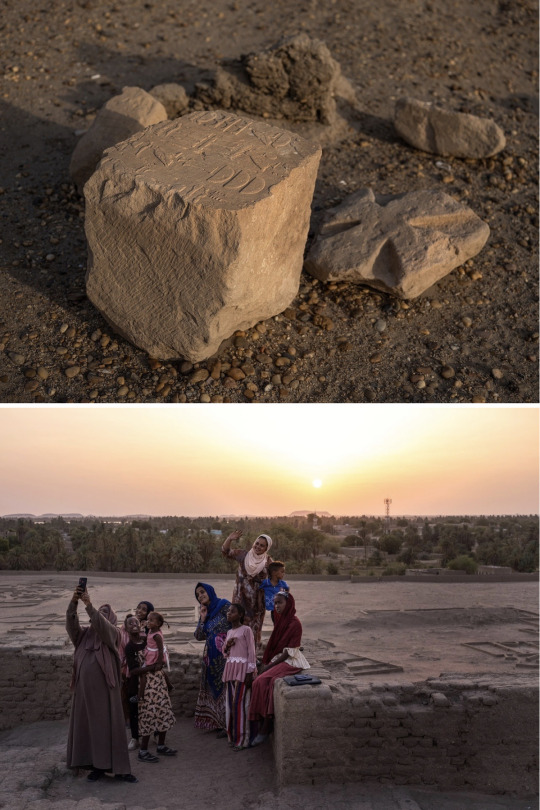
Top: A fragment of an ancient carving sits near the Kerma necropolis. This area of Sudan has been inhabited since Paleolithic times. Bottom: Tahani Abdulaziz takes a photograph of family members during a visit to Kerma.
Haunting Tombs and Dazzling Murals
Just over an hour’s drive south, and slowly being swallowed by sand, is Old Dongola. Founded with a fortress in A.D. 600, it served as the capital of the medieval Nubian kingdom of Makuria and grew to include palaces, houses, and Christian churches. It was a major stop on the Darb al-Arba’in (Forty Days Road) that thousands of camel caravans followed, transporting ivory and slaves between the Sudanese town of Darfur and Egypt.
Best preserved is the Church of the Old Granite Columns, its pale pillars framing a Throne Hall that was converted into a mosque in 1317 and remained in use until 1969. Now it’s open to visitors, along with an adjacent Islamic graveyard with distinctive 17th-century domed tombs known as qubbas.
From there, the Nile loops eastward and you come to El-Kurru, a cemetery used by the royal family of the Kingdom of Kush. Unlike in Egypt, Nubian burial chambers sit below the pyramids, not inside them.
Adobe tunnels cover the entrances to the chambers, chief among them the tomb of King Tanutamun (who died around 653 B.C.). Uneven shallow steps descend into the darkness until a flashlight click reveals a duo of domed rooms, one leading onto the other. Their white gypsum walls are covered with intricate murals in colours of ochre and yellow.
On the back wall is an arresting scene depicting Tanutamun’s heart being weighed against a feather by Maat, the goddess of truth. Kushites believed this recorded a person’s good and bad deeds and determined if the king’s soul could pass into paradise.

A Sudanese family tours El Kurru, a field of pyramids built for the kings and queens of ancient Kush.
More royal tombs crop up in Nuri, further upstream. Its smaller and steeper 70-plus pyramids are now reduced to 20. The most famous tombs belong to King Taharqa, the Black Pharoah who conquered Egypt, and King Nastasen, which archaeologists have to scuba-dive to reach because of rising ground waters.
Nuri served as the royal necropolis for the adjacent town of Napata, the first capital of the Kingdom of Kush. Both the cemetery and the ruins of the settlement lie across the Nile from Jebel Barkal, a 341-foot-tall sandstone mesa. From its summit, you can see the ruins of Nuri, including rows of cracked pillars and pairs of giant stone rams, their eyes and ears worn away by time.
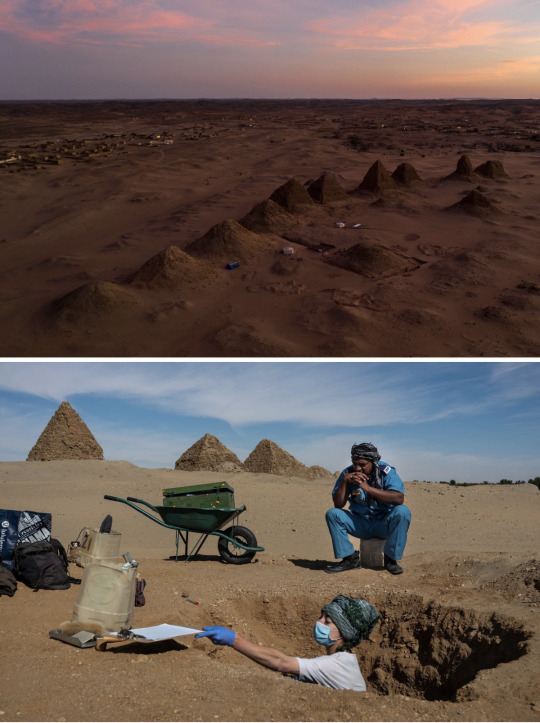
Top: The pyramids of Nuri, Sudan, were built between 650 and 300 B.C. The most famous tomb belongs to King Taharqa, the Black Pharaoh who conquered Egypt. Bottom: Archaeologist Gretchen Emma Zoeller excavates a burial site in Nuri. The ancient site sprawls across more than 170 acres along the Nile in northern Sudan.
On the western side of Jebel Barkal is a crumbling stone door frame leading to the Temple of Mut, wife of Amun. Spotlights illuminate its fine wall murals chronicling Taharqa’s coronation in white clay, ocher, and deep blue.
The World’s Largest Group of Pyramids
Finally, the Nile weaves past Meroë (pronounced Mero-way), the Kushite capital until the empire collapsed in A.D. 400 and site of Sudan’s best-preserved pyramids. More than 200 of them spread across the sands. Their granite and sandstone bases are etched with elephant, giraffe, and gazelle designs, proof that this was once fertile grasslands.
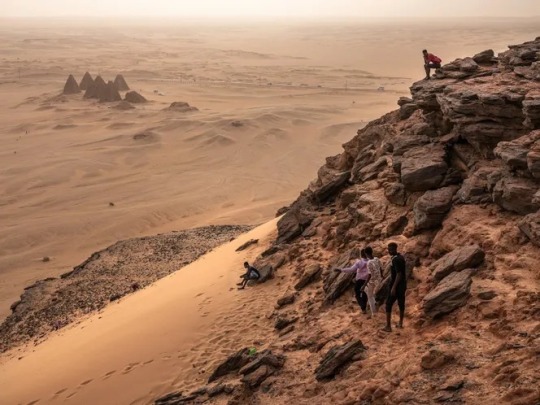
Sudanese tourists visit Jebel Barkal, Sudan, to climb the small butte, which has been considered sacred for thousands of years. Roughly a dozen pyramids are also scattered around the base of the mountain.
“It’s the biggest congregation of pyramids in the world,” reports archaeologist and Meroë site manager, Mahmoud Suliman. “At the time of the 2019 revolution, street signs, advertisements, and paintings all featured their images. It brought people together because the pyramids are so tied to our sense of identity.”
Mentioned in the writings of Herodotus, there’s an air of defiance about these structures that stand firm against the sands trying to swallow them. Indeed, it was an act of resistance that led to their construction in the first place. In the third century B.C., Kushite King Arakamani (Ergamenes) had grown tired of the Meroitic (Meroë-led) kingdom’s power-hungry high priests. So when they sent an order for him to commit suicide, he responded by having them all murdered instead.
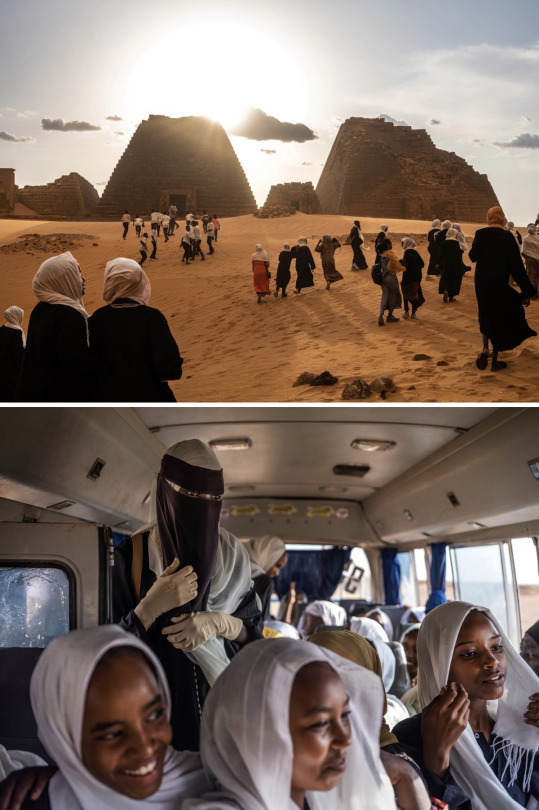
Top: A group of school children approach the pyramids at Meroë. Bottom: Volunteer tour guides show a group of Sudanese school children the Meröe pyramids. During the dictatorship of Omar al-Bashir from 1989 to 2019, Sudan’s school curriculum was infused with Islamic ideology and much of its rich ancient history was glossed over, but the new government wants to change that.
The rebellion ushered in a new era of culture: the almighty Egyptian god Amun-Ra was downgraded in favour of the lion god Abedemak, the (still undeciphered) Meroitic script was created, and warrior queens, known as kandakes, ruled the army. Inside the tombs, the carvings of the kings stand taller than the gods. You won’t see that in Egypt. Here, kings controlled everything except death.
It’s a strong message and one that’s inspired a fresh wave of national pride. For just as Ancient Greece informed so much of today’s European culture, so too did Nubia shape Sudan. It is the bedrock that formed the country’s sense of self and identity. Understanding this history suggests a way forward for Sudan.
“These were very popular kings and queens,” says Aya Allam, a Sudanese martial artist based in Khartoum. “They are a reminder that we were once a great nation and could become great once again.”
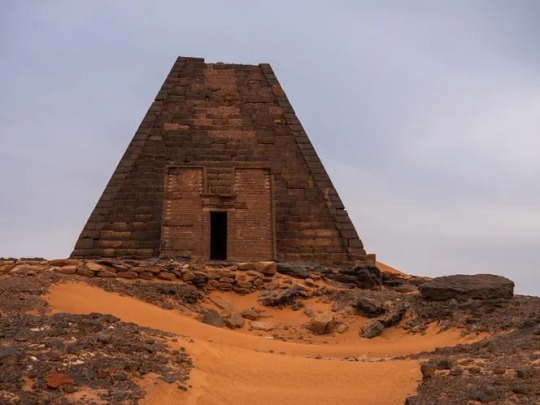
A pyramid covers a tomb in Meroë, Sudan. Rulers of the Kingdom of Kush were buried here underneath the steeply pitched structures, which range in height from 30 to one hundred feet tall, far shorter than the pyramids in nearby Egypt.
— Emma Thomson is a British Travel Writer. Nichole Sobecki is a Kenya-based Photographer.
#African Civilization#Mighty Pyramids#Mysterious Rulers#Sudan 🇸🇩#Tombs#Temples#Egypt 🇪🇬#Cairo#Emma Thompson#Nichole Sobecki#Black Pharaohs#Haunting Tombs | Dazzling Murals
3 notes
·
View notes
Text
Pharaoh taharqa statue

Taharqa was buried at Nuri – North Sudan. Taharqa died in the city of Thebes in 664 BC and was succeeded by his appointed successor Tantamani, a son of Shabaka. Esarhaddon then proceeded to invade Egypt proper in Taharqa’s 17th regnal year, after Esarhaddon had settled a revolt at Ashkelon. His first attack in 677 BC, aimed to pacify Arab tribes around the Dead Sea, led him as far as the Brook of Egypt. It was during his reign that Egypt’s enemy Assyria at last invaded Egypt. Esarhaddon led several campaigns against Taharqa, which he recorded on several monuments. Taharqa took full advantage of the lull in fighting and abundant harvest. In the sixth year of Taharqa’s reign, prosperity was also aided by abundant rainfall and a large harvest. He is one of the few Pharaoh’s mentioned in the bible.ĭuring his reign internal Egypt was one of peace and prosperity, the empire flourished. At the request of Hezekiah King of Israel’s, Taharqa and the Egyptian/Kushite army managed to stall the Assyrian advance on Jerusalem, the capital of Ancient Israel. When Taharqa was about 20 years old, he participated in a historic battle with the Assyrian Emperor, King Sennacherib at Eltekeh. Evidence for the dates of his reign is derived from the Serapeum stela, catalog number 192.Īlthough Taharqa’s reign was filled with conflict with the Assyrians, it was also a prosperous renaissance period in Egypt and Kush. Taharqa’s reign can be dated from 690 BC to 664 BC. Taharqa was also the cousin and successor of Shebitku. Shabaka continued his familys project of religious restoration, adding on to Amuns great temple at Karnak, as well as sanctuaries at Luxor and Medinet Habu. Taharqa was the son of Piye, the Nubian king of Napata who had first conquered Egypt. Piye was succeeded as pharaoh and king of Kush by his brother, Shabaka (ruled c. Taharqa was the sovereigns of the Ancient Egyptian 25th dynasty – The Nubian Dynasty- and monarch of the Kingdom of Kush, which was located in what is now modern day Northern Sudan. Provided by an Albawaba.Source: Wikimedia Commons Neithsabes (travail personnel / Minolta DiMAGE Xt) History," she said, adding more digs were being planned in the "The world is discovering Sudan and its fantastic and exciting Sudan in the British Museum, said working in Sudan was "incrediblyĮxciting" because so little had been excavated. Some 300 km south (by Nile) of the previously known Kushite royal site.Īnderson, assistant keeper in the Department of Ancient Egypt and to the 6th century B.C." he told Reuters, adding the site was "These statues belong to kings from between the 8th centuryī.B. Than its better known neighbor Egypt and more were being discovered This was a period of Kushite rule, which means that Taharqa and his fellow rulers were from Nubia and drew their power-base from there. Taharqa was a pharaoh of the 25th dynasty of Egypt. Salah Mohamed Ahmed, Director of Fieldwork in the NationalĬorporation for Antiquities and Museums, said Sudan had more pyramids Archaeologists have found a massive one ton granite statue of the Egyptian pharaoh Taharqa has been found in Dangeil, deep inside Sudan. Trade routes, the waters of the river Nile, gold and agriculture. The Kushite empire ruled for so long because it had control of The names of the kings were written in hieroglyphics on the backs Pharaoh who came south to assert authority. Which may have been due to internal dynastic disputes or an Egyptian Have been deliberately broken at the neck, knees and ankles in a ritual,

The granite life-size statues would weigh 1.5 tons but appeared to Well as part of a crown of a fourth royal who they have yet to identify. The dig found four royal statues, of Pharaoh Taharqa (690-664ī.C.), kings Senkamanisken (643-623 B.C.) and Aspelta (593-568 B.C.) as "This is the furthest south that we know of that a statue of "It's an amazing shock that we'veįound the statues there particularly Taharqa," said Julie Anderson,Ĭo-director of the project in Dangail, about 350 km (217.5 miles) north The Kushite civilisation survived from 9th century B.C. The Pharaoh Taharqa, mentioned in the Bible for saving Jerusalemįrom the Assyrians, was a Kushite from north Sudan but ruled a wideĮmpire through Egypt to the borders of Palestine. The expansive Kushite empire extended, the dig directors said on Monday. In Sudan, a discovery that has shocked archaeologists at how far south Huge granite statues of a pharaoh and other kings have been found Summary: Huge granite statues of a pharaoh and other kings haveīeen found in Sudan, a discovery that has shocked archaeologists at howįar south the expansive Kushite empire extended, the dig directors said
APA style: Pharaoh and king statues found in Sudan.
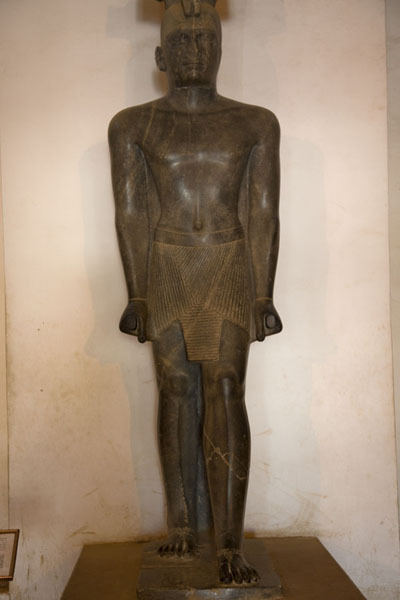
Pharaoh and king statues found in Sudan." Retrieved from
MLA style: "Pharaoh and king statues found in Sudan." The Free Library.

2 notes
·
View notes
Text
Historic Sites of the World: A Journey Through Time
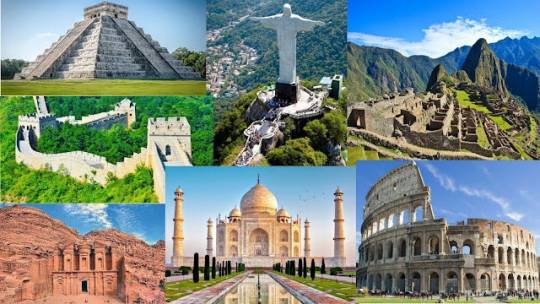
Embarking on a journey to the historic sites of the world is like flipping through the pages of a living history book. Each site tells a story, whispers secrets of the past, and offers a tangible connection to the epochs and people who shaped our world. From the pyramids of Egypt to the ancient ruins of Greece, these sites stand as testaments to human ingenuity and perseverance.
The Importance of Historic Sites
Historic sites are much more than mere tourist attractions; they are vital links to our past, offering tangible connections to different eras and cultures.
Cultural Significance: These sites are key to understanding various cultures and civilizations. They provide insights into historical events, social structures, and the everyday lives of people from different times.
Educational Value: Historic sites serve as open-air museums, providing educational opportunities for all ages. They help in bringing history to life, making it more tangible and relatable.
Preservation of Heritage: Protecting these sites ensures that future generations can learn from and appreciate our shared human history. They are a testament to human achievements, struggles, and evolutions.
UNESCO World Heritage Sites: Preserving Global Heritage
UNESCO World Heritage Sites are landmarks recognized for their outstanding universal value to humanity, whether cultural, historical, scientific, or natural.
Global Recognition: These sites are deemed so valuable to the world that their preservation is considered important for all people, regardless of their origin. Examples include the Taj Mahal in India, the Great Barrier Reef in Australia, and the Galápagos Islands in Ecuador.
Conservation Efforts: Being listed as a UNESCO World Heritage Site helps in securing international support and funding for conservation efforts. This status also raises awareness about the importance of preserving these sites.
Cultural Diversity and Unity: UNESCO sites showcase the diversity of human culture and natural landscapes across the globe, yet they also highlight the universal values that connect us all.
Ancient Civilizations and Their Ruins
The ruins of ancient civilizations offer a unique window into the past, allowing us to witness the remains of bygone societies.
Egyptian Civilization: The pyramids and temples along the Nile River Valley, such as those in Luxor and Giza, offer insights into ancient Egyptian beliefs, social structure, and architectural prowess.
Greek and Roman Civilizations: Ruins like the Parthenon in Athens and the Forum in Rome illustrate the advancement in politics, philosophy, and arts achieved by these civilizations.
Mesoamerican Civilizations: Sites such as Chichen Itza in Mexico and Machu Picchu in Peru reveal the complexity of societies like the Mayans and Incas, particularly in astronomy, architecture, and agriculture.
The Art of Preservation and Restoration
Preserving and restoring historic sites is both an art and a science, essential in keeping the legacy of our past alive.
Challenges of Preservation: The main challenge in historic preservation is to maintain the authenticity and integrity of the site while ensuring its longevity. Environmental factors, human-induced damage, and the passage of time all pose threats to these ancient landmarks.
Restoration Techniques: Restoration often involves meticulous research and the use of traditional techniques and materials. For instance, the restoration of the Acropolis in Athens involves careful study of ancient techniques to preserve its original appearance.
Role of Technology: Advanced technologies like 3D scanning and digital modeling play a significant role in restoration projects, allowing for accurate repairs and reconstructions.
Architectural Marvels Through the Ages
The world's architectural marvels provide a physical timeline of human history, showcasing the evolution of design and construction techniques.
Classical Architecture: Ancient Greece and Rome set the foundations for Western architecture. Structures like the Parthenon and the Colosseum are emblematic of the classical architectural styles that have influenced generations.
Gothic Architecture: This style, flourishing in medieval Europe, is characterized by its pointed arches, ribbed vaults, and flying buttresses, with the Notre-Dame Cathedral in Paris being a prime example.
Modernist Architecture: The 20th century brought about architectural modernism, focusing on functionality and simplicity. The Guggenheim Museum in New York exemplifies this shift with its unique, spiral design by Frank Lloyd Wright.
Museums: Gateways to the Past
Museums play a crucial role in preserving and showcasing humanity's cultural and historical heritage.
Custodians of History: Museums house priceless artifacts and artworks, ranging from prehistoric tools to contemporary pieces, acting as custodians of human history.
Educational Role: They serve an educational purpose, offering visitors insights into different cultures, eras, and societies. Interactive exhibits and educational programs help bring history to life for all ages.
Iconic Institutions: Some of the world's most famous museums, such as the Louvre in Paris, the British Museum in London, and the Smithsonian Institution in Washington, D.C., not only house extensive collections but are also architectural marvels in their own right.
The Process and Significance of Archaeological Excavation
Archaeological excavations are key to uncovering the mysteries of the past and understanding the development of human civilization.
Excavation Process: This involves carefully unearthing artifacts and structures from beneath the earth, using a combination of meticulous digging and state-of-the-art technology. Every layer of soil can reveal information about different periods in history.
Discovery and Analysis: Artifacts, from everyday utensils to elaborate tombs, provide insights into the lives, cultures, and technologies of ancient peoples. After discovery, these items are analyzed in laboratories to glean as much information as possible.
Reconstructing History: Excavations help historians and archaeologists reconstruct historical events and understand societal evolution. For instance, the excavation of Pompeii has provided an unparalleled window into Roman life.
Cultural Tourism: Experiencing History Firsthand
Cultural tourism offers an immersive way to experience the rich tapestry of the world's historical and cultural heritage.
Engaging with Heritage: Traveling to historic sites, from ancient ruins to cultural landmarks, allows tourists to experience the essence of different cultures firsthand.
Learning and Interaction: Engaging with local guides, participating in traditional workshops, and attending cultural events can provide deeper insights into the heritage and customs of a place.
Supporting Local Economies: Cultural tourism can significantly contribute to local economies, often helping to preserve traditional crafts and practices.
Conservation Ethics in Historical Tourism
Responsible tourism is essential in ensuring the sustainability and preservation of historical sites.
Preservation of Sites: Tourists should follow guidelines aimed at protecting and conserving sites, such as sticking to designated paths and refraining from touching fragile structures or artifacts.
Responsible Behavior: This includes respecting local customs and traditions, not contributing to overcrowding at popular sites, and being mindful of the environmental impact of tourism.
Supporting Conservation Efforts: Tourists can contribute to conservation efforts by visiting sites managed ethically, participating in educational tours, and supporting local businesses that practice sustainable tourism.
Conclusion
Visiting historic sites is a profound experience, deepening our understanding of humanity's journey. As you plan your travels to these remarkable destinations, navigating visa requirements can be a complex aspect of your journey. Services like GovAssist can assist in streamlining your visa application process, ensuring a hassle-free start to your historical exploration.
0 notes
Text
Holidays 9.18
Holidays
Aging Awareness Day
Big Brothers Big Sisters Day (Canada)
Celebrate Your Name Day
Celebration of Talent (French Republic)
Chiropractic Founder’s Day
Clemente Day
Day of National Music (Azerbaijan)
Dieciocho (Chile)
Eleven Days of Global Unity, Day 8: Human Rights
European Heritage Days (EU)
Feast Day of the Walloon Region (Belgium)
Festival of Inner Worlds
Fiesta Patrias (Chile)
First Love Day
Global Company Culture Day
Hug a Greeting Card Writer Day
International Equal Pay Day (UN)
International Pitt Hopkins Awareness Day
International Read an eBook Day
Island Language Day (Okinawa, Japan)
Jeannie in a Bottle Day
Jitiya Parwa (Only Women Employees; Nepal)
Jonny Quest Day
Long Playing Record Day
Mickey Mantle Day (New York)
Mid-Autumn Festival Holiday (Taiwan)
National Cannabis Day (Germany)
National Ceiling Fan Day
National Colton Day
National HIV/AIDS and Aging Awareness Day
National Museum Day [also 5.18]
National Play-Dough Day
National Report Kickback Fraud Day
National Respect! Day
Navy Day (Croatia)
New York Times Day
PCOS Awareness Day
Scouring of the White Horse (Wantage, Berkshire, UK)
Shimakutuba Day (Okinawa)
Top Ten List Day
U.S. Air Force Day
World Bamboo Day
World Medical Ethics Day
World Water Monitoring Day
Food & Drink Celebrations
National Brett Day
National Cheeseburger Day
National Chocolate Day
Rice Krispies Treats Day
3rd Monday in September
Bettagsmontag (Switzerland) [Monday after 3rd Sunday]
Human Rights Day (Antarctica) [3rd Monday]
National Cupcake Week begins (UK) [3rd Monday]
National Woman Road Warrior Day [3rd Monday]
Respect For the Aged Day (Japan) [3rd Monday]
Independence Days
Buddie Union (Declared; 2015) [unrecognized]
Chile (a.k.a. Dieciocho, 1st Gov't Junta, 1818)
Free Republic of Silbervia (Declared; 2020) [unrecognized]
Feast Days
Amoeba Assimilation Day (Pastafarian)
Anton Mauve (Artology)
Arcadius, Bishop of Novgorod (Christian; Saint)
Ariadne of Phrygia (Christian; Martyr)
Bidzin, Elizbar, and Shalva, Princes of Georgia (Christian; Martyrs)
Castor of Alexandria (Christian; Martyr)
Constantius (Theban Legion)
Edward Bouverie Pusey (Episcopal Church)
Eugene’s, Bishop of Gortyna (Christian; Saint)
Eustorgius I (Christian; Saint)
Ferreol (Christian; Saint)
Feast of Ceres (Roman Goddess of Agriculture & Grain Crops)
Festival of Labour (French Republic)
Hilarion of Optima (Christian; Saint)
John Harvey Kellogg Day (Church of the SubGenius; Saint)
Joseph of Cupertino (Christian; Saint)
Juan Macias (Christian; Saint)
Leonardo da Crunchy (Muppetism)
Mark di Suvero (Artology)
Methodius of Olympus (Christian; Saint)
Plataia (Ancient Greece)
Richardis (Christian; Saint)
Sophia and Irene of Egypt (Christian; Martyrs)
Third Nostril of Christ Day (Church of the SubGenius)
Thomas of Villanova (Christian; Saint)
Tzom Gedaliah (Fast of Gedalia; Judaism)
Vanaheim Day (Pagan)
Vondel (Positivist; Saint)
Zay Day (Sus God Zay) [Wear red or purple hoodies]
Lucky & Unlucky Days
Fortunate Day (Pagan) [38 of 53]
Taian (大安 Japan) [Lucky all day.]
Tycho Brahe Unlucky Day (Scandinavia) [31 of 37]
Unglückstage (Unlucky Day; Pennsylvania Dutch) [24 of 30]
Unlucky 18th (Philippines) [3 of 3]
Premieres
Abacab, by Genesis (Album; 1981)
The Addams Family (TV Series; 1964)
Birthday, recorded by The Beatles (Song; 1967)
Cat on a Hot Tin Roof (Film; 1958)
Cloudy with a Chance of Meatballs (Animated Film; 2009)
Continental Divide (Film; 1981)
The Day the Earth Stood Still (Film; 1951)
Dog Daze (WB MM Cartoon; 1937)
Enough Said (Film; 2013)
Fatal Attraction (Film; 1987)
The French Lieutenant’s Woman (Film; 1981)
Funny Girl (Film; 1968)
Gene Simmons, Paul Stanley, Ace Frehley, and Peter Criss (Albums; 1978)
Goldfinger premiered in UK (1964) [James Bond #3]
Goo Goo Goliath (WB MM Cartoon; 1954)
Heartache Tonight, by The Eagles (Song; 1979)
In the Night Kitchen, by Maurice Sendak (Children’s Book; 1970)
Jennifer’s Body (Film; 2009)
Jonny Quest (Animated TV Series; 1964)
Making Money, by Terry Pratchet (Novel; 2007) [Discworld #36]
Maple Leaf Rag, by Scott Joplin (Song; 1899)
Maze Runner: The Scorch Trials (Film; 2015)
More Than a Feeling,, by Boston (Song; 1976)
The Road to Ruin or Mine Over Matter (Rocky & Bullwinkle Cartoon, S2, Ep. 55; 1960)
Rush Hour (Film; 1998)
The Scorch Trials, by James Dashner (Novel; 2010) [Maze Runner #2]
Serve It Forth (Art of Eating), by M.F.K. Fisher (Food Essays; 1937)
Severed Relations or How to Get a Head (Rocky & Bullwinkle Cartoon, S4, Ep. 161; 1962)
Sicario (Film; 2015)
Singles (Film; 1992)
Smiley Smile, by The Beach Boys (Album; 1967)
Strange Little Girl, by Tori Amos (Album; 2001)
A Streetcar Named Desire (Film; 1951)
Studio 60 on the Sunset Strip (TV Series; 2006)
Superman: Doomsday (WB Animated Film; 2007)
That’s the Way the Cookie Crumbles or Me and My Chateau (Rocky & Bullwinkle Cartoon, S4, Ep. 162; 1962)
Tired and Feathered (WB LT Cartoon; 1965)
Two Flying Ghosts or High Spirits (Rocky & Bullwinkle Cartoon, S2, Ep. 56; 1960)
Wagon Train (TV Series; 1957)
War Pigs, by Black Sabbath (Song; 1970)
Where’s Wally, by Martin Hanford (Puzzle Book; 1987)
WKRP in Cincinnati (TV Series; 1978)
Today’s Name Days
Herlinda, Josef, Lambert, Rica (Austria)
Alfonz, Irena, Jonatan, Josip, Sonja (Croatia)
Kryštof, Oskar (Czech Republic)
Titus (Denmark)
Tiido, Tiidrik, Tiidu, Tiit (Estonia)
Tytti, Tyyne, Tyyni (Finland)
Nadège, Véra (France)
Alfons, Herlinde, Lambert, Rica (Germany)
Ariadne, Ariadni, Evmenis, Kastor, Romylos (Greece)
Diána (Hungary)
Eumenio, Giuseppe, Maria, Sofia (Italy)
Alinta, Elita, Gizela, Liesma (Latvia)
Galmantė, Mingailas, Stefa, Stefanija (Lithuania)
Henriette, Henry (Norway)
Dobrowit, Irena, Irma, Józef, Ryszarda, Stefania, Tytus, Zachariasz (Poland)
Eumenie (Romania)
Elizaveta, Raisa (Russia)
Eugénia (Slovakia)
José, Sofía, Sonia (Spain)
Orvar (Sweden)
Irene (Ukraine)
Clint, Clinton, Corbin, Corwin, Corwyn, Korbin, Korvin (USA)
Today is Also…
Day of Year: Day 261 of 2024; 104 days remaining in the year
ISO: Day 1 of week 38 of 2023
Celtic Tree Calendar: Muin (Vine) [Day 14 of 28]
Chinese: Month 8 (Xin-You), Day 4 (Ji-Mao)
Chinese Year of the: Rabbit 4721 (until February 10, 2024)
Hebrew: 3 Tishri 5784
Islamic: 3 Rabi I 1445
J Cal: 21 Aki; Sevenday [21 of 30]
Julian: 5 September 2023
Moon: 12%: Waxing Crescent
Positivist: 9 Shakespeare (10th Month) [Vondel]
Runic Half Month: Ken (Illumination) [Day 7 of 15]
Season: Summer (Day 89 of 94)
Zodiac: Virgo (Day 28 of 32)
1 note
·
View note
Text
Holidays 9.18
Holidays
Aging Awareness Day
Big Brothers Big Sisters Day (Canada)
Celebrate Your Name Day
Celebration of Talent (French Republic)
Chiropractic Founder’s Day
Clemente Day
Day of National Music (Azerbaijan)
Dieciocho (Chile)
Eleven Days of Global Unity, Day 8: Human Rights
European Heritage Days (EU)
Feast Day of the Walloon Region (Belgium)
Festival of Inner Worlds
Fiesta Patrias (Chile)
First Love Day
Global Company Culture Day
Hug a Greeting Card Writer Day
International Equal Pay Day (UN)
International Pitt Hopkins Awareness Day
International Read an eBook Day
Island Language Day (Okinawa, Japan)
Jeannie in a Bottle Day
Jitiya Parwa (Only Women Employees; Nepal)
Jonny Quest Day
Long Playing Record Day
Mickey Mantle Day (New York)
Mid-Autumn Festival Holiday (Taiwan)
National Cannabis Day (Germany)
National Ceiling Fan Day
National Colton Day
National HIV/AIDS and Aging Awareness Day
National Museum Day [also 5.18]
National Play-Dough Day
National Report Kickback Fraud Day
National Respect! Day
Navy Day (Croatia)
New York Times Day
PCOS Awareness Day
Scouring of the White Horse (Wantage, Berkshire, UK)
Shimakutuba Day (Okinawa)
Top Ten List Day
U.S. Air Force Day
World Bamboo Day
World Medical Ethics Day
World Water Monitoring Day
Food & Drink Celebrations
National Brett Day
National Cheeseburger Day
National Chocolate Day
Rice Krispies Treats Day
3rd Monday in September
Bettagsmontag (Switzerland) [Monday after 3rd Sunday]
Human Rights Day (Antarctica) [3rd Monday]
National Cupcake Week begins (UK) [3rd Monday]
National Woman Road Warrior Day [3rd Monday]
Respect For the Aged Day (Japan) [3rd Monday]
Independence Days
Buddie Union (Declared; 2015) [unrecognized]
Chile (a.k.a. Dieciocho, 1st Gov't Junta, 1818)
Free Republic of Silbervia (Declared; 2020) [unrecognized]
Feast Days
Amoeba Assimilation Day (Pastafarian)
Anton Mauve (Artology)
Arcadius, Bishop of Novgorod (Christian; Saint)
Ariadne of Phrygia (Christian; Martyr)
Bidzin, Elizbar, and Shalva, Princes of Georgia (Christian; Martyrs)
Castor of Alexandria (Christian; Martyr)
Constantius (Theban Legion)
Edward Bouverie Pusey (Episcopal Church)
Eugene’s, Bishop of Gortyna (Christian; Saint)
Eustorgius I (Christian; Saint)
Ferreol (Christian; Saint)
Feast of Ceres (Roman Goddess of Agriculture & Grain Crops)
Festival of Labour (French Republic)
Hilarion of Optima (Christian; Saint)
John Harvey Kellogg Day (Church of the SubGenius; Saint)
Joseph of Cupertino (Christian; Saint)
Juan Macias (Christian; Saint)
Leonardo da Crunchy (Muppetism)
Mark di Suvero (Artology)
Methodius of Olympus (Christian; Saint)
Plataia (Ancient Greece)
Richardis (Christian; Saint)
Sophia and Irene of Egypt (Christian; Martyrs)
Third Nostril of Christ Day (Church of the SubGenius)
Thomas of Villanova (Christian; Saint)
Tzom Gedaliah (Fast of Gedalia; Judaism)
Vanaheim Day (Pagan)
Vondel (Positivist; Saint)
Zay Day (Sus God Zay) [Wear red or purple hoodies]
Lucky & Unlucky Days
Fortunate Day (Pagan) [38 of 53]
Taian (大安 Japan) [Lucky all day.]
Tycho Brahe Unlucky Day (Scandinavia) [31 of 37]
Unglückstage (Unlucky Day; Pennsylvania Dutch) [24 of 30]
Unlucky 18th (Philippines) [3 of 3]
Premieres
Abacab, by Genesis (Album; 1981)
The Addams Family (TV Series; 1964)
Birthday, recorded by The Beatles (Song; 1967)
Cat on a Hot Tin Roof (Film; 1958)
Cloudy with a Chance of Meatballs (Animated Film; 2009)
Continental Divide (Film; 1981)
The Day the Earth Stood Still (Film; 1951)
Dog Daze (WB MM Cartoon; 1937)
Enough Said (Film; 2013)
Fatal Attraction (Film; 1987)
The French Lieutenant’s Woman (Film; 1981)
Funny Girl (Film; 1968)
Gene Simmons, Paul Stanley, Ace Frehley, and Peter Criss (Albums; 1978)
Goldfinger premiered in UK (1964) [James Bond #3]
Goo Goo Goliath (WB MM Cartoon; 1954)
Heartache Tonight, by The Eagles (Song; 1979)
In the Night Kitchen, by Maurice Sendak (Children’s Book; 1970)
Jennifer’s Body (Film; 2009)
Jonny Quest (Animated TV Series; 1964)
Making Money, by Terry Pratchet (Novel; 2007) [Discworld #36]
Maple Leaf Rag, by Scott Joplin (Song; 1899)
Maze Runner: The Scorch Trials (Film; 2015)
More Than a Feeling,, by Boston (Song; 1976)
The Road to Ruin or Mine Over Matter (Rocky & Bullwinkle Cartoon, S2, Ep. 55; 1960)
Rush Hour (Film; 1998)
The Scorch Trials, by James Dashner (Novel; 2010) [Maze Runner #2]
Serve It Forth (Art of Eating), by M.F.K. Fisher (Food Essays; 1937)
Severed Relations or How to Get a Head (Rocky & Bullwinkle Cartoon, S4, Ep. 161; 1962)
Sicario (Film; 2015)
Singles (Film; 1992)
Smiley Smile, by The Beach Boys (Album; 1967)
Strange Little Girl, by Tori Amos (Album; 2001)
A Streetcar Named Desire (Film; 1951)
Studio 60 on the Sunset Strip (TV Series; 2006)
Superman: Doomsday (WB Animated Film; 2007)
That’s the Way the Cookie Crumbles or Me and My Chateau (Rocky & Bullwinkle Cartoon, S4, Ep. 162; 1962)
Tired and Feathered (WB LT Cartoon; 1965)
Two Flying Ghosts or High Spirits (Rocky & Bullwinkle Cartoon, S2, Ep. 56; 1960)
Wagon Train (TV Series; 1957)
War Pigs, by Black Sabbath (Song; 1970)
Where’s Wally, by Martin Hanford (Puzzle Book; 1987)
WKRP in Cincinnati (TV Series; 1978)
Today’s Name Days
Herlinda, Josef, Lambert, Rica (Austria)
Alfonz, Irena, Jonatan, Josip, Sonja (Croatia)
Kryštof, Oskar (Czech Republic)
Titus (Denmark)
Tiido, Tiidrik, Tiidu, Tiit (Estonia)
Tytti, Tyyne, Tyyni (Finland)
Nadège, Véra (France)
Alfons, Herlinde, Lambert, Rica (Germany)
Ariadne, Ariadni, Evmenis, Kastor, Romylos (Greece)
Diána (Hungary)
Eumenio, Giuseppe, Maria, Sofia (Italy)
Alinta, Elita, Gizela, Liesma (Latvia)
Galmantė, Mingailas, Stefa, Stefanija (Lithuania)
Henriette, Henry (Norway)
Dobrowit, Irena, Irma, Józef, Ryszarda, Stefania, Tytus, Zachariasz (Poland)
Eumenie (Romania)
Elizaveta, Raisa (Russia)
Eugénia (Slovakia)
José, Sofía, Sonia (Spain)
Orvar (Sweden)
Irene (Ukraine)
Clint, Clinton, Corbin, Corwin, Corwyn, Korbin, Korvin (USA)
Today is Also…
Day of Year: Day 261 of 2024; 104 days remaining in the year
ISO: Day 1 of week 38 of 2023
Celtic Tree Calendar: Muin (Vine) [Day 14 of 28]
Chinese: Month 8 (Xin-You), Day 4 (Ji-Mao)
Chinese Year of the: Rabbit 4721 (until February 10, 2024)
Hebrew: 3 Tishri 5784
Islamic: 3 Rabi I 1445
J Cal: 21 Aki; Sevenday [21 of 30]
Julian: 5 September 2023
Moon: 12%: Waxing Crescent
Positivist: 9 Shakespeare (10th Month) [Vondel]
Runic Half Month: Ken (Illumination) [Day 7 of 15]
Season: Summer (Day 89 of 94)
Zodiac: Virgo (Day 28 of 32)
1 note
·
View note
Text
Exploring Ancient Egypt: From Agricultural Artifacts to Luxurious Nile Cruises
@cairo-top-tours
1 note
·
View note
Text
1 note
·
View note
Video
At Egypt's Spring Flowers Fair 2023 at the Agricultural Museum by Zeinab Mohamed
0 notes
Text
7 Major Cultural and Technological Advancements that Shaped the World
youtube
From the dawn of human civilization to the birth of Christianity, the world underwent significant cultural and technological advancements that paved the way for modern society. These developments were achieved through the collective efforts of numerous civilizations and cultures that left their mark on history. In this article, we will take a look at some of the major cultural and technological advancements in pre-Christian times that shaped the world as we know it today.
One of the most notable cultural advancements of pre-Christian times was the development of writing. Early forms of writing, such as cuneiform in Mesopotamia and hieroglyphs in Egypt, emerged around 3000 BC. Writing allowed civilizations to record history, communicate complex ideas, and share knowledge across vast distances. The creation of writing was a significant step towards the development of modern culture.
Another cultural advancement was the creation of the world's first known cities, which emerged in Mesopotamia around 4000 BC. These cities were centers of trade, politics, and religion, and they facilitated the growth of complex societies. The city of Ur, for example, was one of the largest and most prosperous cities of its time, boasting impressive structures such as the Ziggurat of Ur.
Art and architecture also experienced significant advancements during pre-Christian times. Greek architecture, for example, was characterized by its use of columns, pediments, and friezes, which are still evident in modern-day buildings such as the White House and the British Museum. In addition, Greek art, including pottery and sculpture, displayed an unparalleled level of detail and skill.
Technological advancements were also prevalent in pre-Christian times. The development of metallurgy, or the ability to extract and use metals, allowed for the creation of weapons, tools, and other essential items. The use of iron, in particular, was a significant technological advancement that allowed civilizations to produce stronger and more durable tools and weapons.
In addition, agriculture underwent significant advancements during pre-Christian times. The invention of the plow, for example, allowed farmers to cultivate land more efficiently, leading to an increase in food production and the growth of larger populations. The domestication of animals, such as horses and cattle, also allowed for more efficient transportation and labor.
In conclusion, the cultural and technological advancements of pre-Christian times paved the way for the development of modern society. From the invention of writing and the creation of the world's first cities to the advancements in art, architecture, metallurgy, and agriculture, these advancements were achieved through the collective efforts of numerous civilizations and cultures. These achievements continue to influence and shape the world today, and they serve as a testament to the ingenuity and creativity of humanity.
culture #technology #history #civilization #writing #cities #art #architecture #metallurgy #agriculture
0 notes
Photo
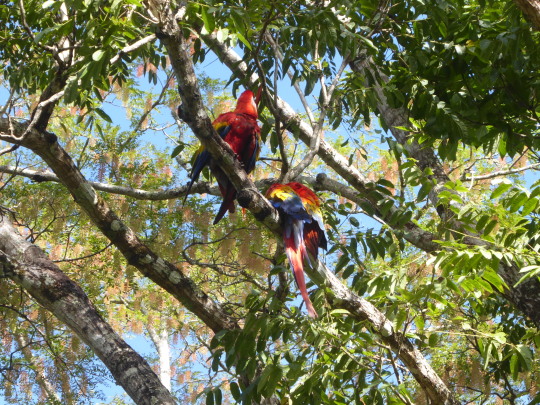
Honduras and specifically Copan
Link to my albums https://photos.app.goo.gl/cDvLkKDZMgqYGnbX7
https://photos.app.goo.gl/NLz8AeBFN8ELowhR8
Just as I didn’t really take enough pictures to do El Salvador justice, the same issue arrived in Honduras. Central American roads are unpredictable as are fellow travelers needs, and combined with an awesome tour guide who could talk for hours (and sometimes did) - it seems as if we were always arriving to our next destination too late for free time and then the next day was packed full of adventures. That’s what happened with Honduras....it took us the better part of a day to cross two borders (El Salvador to Guatemala and then Guatemala to Honduras) and get settled into our hotel in the small town of Copan Ruinas. Day 2 was full of a visit to Copan and then the next morning we were off to cross the border once again for the Guatemala part of our trip.
That said, the two most famous tourist attractions in Honduras are Copan and the Bay Islands, and I’d visited Roatan (the biggest island) on a couple of cruises.
Copan is known for its amazing carvings and overall artistry - I’ve heard it refered to as the Paris of the Mayan Empire. And it didn’t disappoint....it was the most beautiful Mayan site I’d seen. There were amazing carvings...and although I didn’t have time to visit the museum - it seems that there is a reconstruction of the Rosalila Temple (a temple found buried within another temple) that would have been nice to see. Mayan temples were brightly painted.....and because this one had been buried for more than 1500 years, the colors were still there and have helped a lot with understanding what the buildings really looked like.
Copan has also been a great help in understanding the history of the Maya. It was ruled by a dynastly of leaders from the same family for more than 400 years and each of them left their mark on the city, much the way that the Pharoahs of Egypt did.
I thought I knew a lot about the Maya before I took this trip, but I really didn’t. It seems as if its only been since the 1970s that serious excavations and restorations have taken place - and of course in many cases they were interrupted by the civil wars in El Salvador and Guatemala. Also, the Spanish destroyed most of the Mayan written records as blasphemy, and although the Mayan spoken language continued to be used among the local population, the ability to read the hieroglyphs was lost. Its only been since the 1970s that experts began to decipher Mayan writing well enough to understand the messages carved into the altars, stela, and staircases at Copan and other sites.
Many mysteries still surround the Maya - by the time of the Spanish conquest, although the Mayan people still existed, they had abandoned the great cities of the past and lived in smaller villages, working primarily in agriculture. And for whatever reason, although much knowledge was passed down from each generation, the stories didn’t include the reasons for the abandonment. All we know for sure is that in the case of Copan - the building and creation of carvings stopped rather abruptly which indicates that the city collapsed sometime between 800 and 830 AD. Other Mayan cities such as Tikal and Palenque seem to have been abandoned around the same time.
0 notes